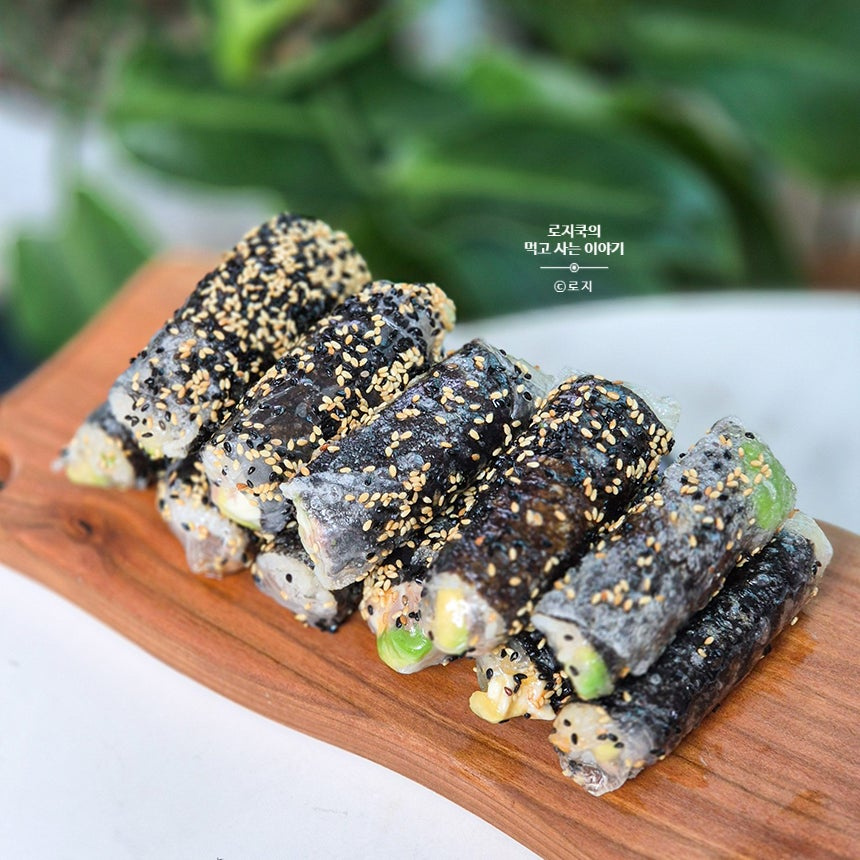Crispy Rice Paper Mini Gimbap Fritters
Crispy and Chewy Tuna Avocado Cucumber Rice Paper Mini Gimbap Fritters Recipe

These mini gimbap fritters offer a delightful contrast of crispy exteriors and chewy interiors. They make for a simple yet satisfying meal or a unique snack. The fantastic combination of creamy avocado, savory tuna, and crisp cucumber is sure to please everyone, so if you’re looking for a novel gimbap recipe, be sure to give this a try!
Gimbap Ingredients- 5 sheets of gimbap seaweed (if using regular gimbap seaweed, cut into quarters to make about 10 pieces)
- 1-2 ripe avocados
- 1 can of tuna (150g), drained
- 20 sheets of rice paper
- A pinch of white or toasted sesame seeds
Sauce- Sriracha sauce (to taste)
- Mayonnaise (to taste)
Seasoned Rice- 2 bowls of cooked rice (approx. 400g)
- 1/2 teaspoon salt (measuring spoon)
- 1 teaspoon sugar (measuring spoon)
- 3 tablespoons vinegar (tablespoon)
- Sriracha sauce (to taste)
- Mayonnaise (to taste)
Seasoned Rice- 2 bowls of cooked rice (approx. 400g)
- 1/2 teaspoon salt (measuring spoon)
- 1 teaspoon sugar (measuring spoon)
- 3 tablespoons vinegar (tablespoon)
Cooking Instructions
Step 1
First, wash the cucumbers thoroughly, trim off the ends, and then cut them lengthwise in half.

Step 2
Using a spoon, carefully scoop out the seeds from the center of the halved cucumbers. This step helps create a stable base for the fillings.

Step 3
Slice the seeded cucumbers lengthwise into strips suitable for gimbap filling. Avoid slicing them too thinly to maintain a satisfying crunch.

Step 4
Cut the cucumber strips into approximately 3-4 smaller pieces. This makes them easier to handle when rolling the mini gimbap and ensures an even distribution of filling.

Step 5
For the avocados, trim off the very ends. Then, insert a knife at an angle and make a cut around the circumference. Gently twist the two halves to separate them. Use a spoon to carefully remove the pit.

Step 6
Peel the avocado halves and slice them into pieces of a suitable thickness for the gimbap filling. Be careful not to slice them too thinly, as they can become mushy.

Step 7
Now, let’s prepare the seasoned rice. In a bowl, combine 2 bowls of cooked rice with 1/2 teaspoon of salt and 1 teaspoon of sugar.

Step 8
Add 3 tablespoons of vinegar to the bowl. Gently mix with a spatula or spoon, being careful not to mash the rice grains, until the vinegar mixture is evenly distributed.

Step 9
Microwave the seasoned rice for about 30 seconds. This will help the rice become chewier and more flavorful.

Step 10
Add the prepared vinegar mixture to the warm rice. Gently mix the rice with a spatula, ensuring each grain is coated with the seasoning without clumping. It’s important to mix lightly so the rice grains remain distinct.

Step 11
Drain the canned tuna by placing it in a sieve and pressing firmly with a spoon to remove as much oil as possible. This step prevents the gimbap filling from being greasy and ensures a cleaner taste.

Step 12
We’ve used small gimbap seaweed sheets, perfect for mini gimbap. If you’re using regular gimbap seaweed, cut each sheet into four equal pieces. Spread a thin layer of the seasoned rice evenly over the seaweed sheet. Avoid spreading the rice too thickly, as this can cause the gimbap to break when rolled.

Step 13
Arrange the prepared cucumber and avocado slices attractively over the rice. Don’t overfill, as this can make it difficult to roll and may cause the gimbap to come apart.

Step 14
Evenly distribute the drained tuna over the fillings. Gently spread the tuna to prevent it from clumping together.

Step 15
Drizzle mayonnaise and sriracha sauce in a zigzag pattern over the tuna, according to your preference. The combination of spicy and creamy flavors will enhance the overall taste.

Step 16
Carefully roll the gimbap tightly from the bottom up, ensuring the fillings stay inside and the seaweed doesn’t tear. Rolling it into a small, compact shape is key.

Step 17
Now it’s time to use the rice paper. Prepare a shallow dish with hot water and briefly dip each sheet of rice paper in the water until it becomes pliable. Be careful not to soak it for too long, as it can tear.

Step 18
Sprinkle a little sesame seeds onto the softened rice paper. Place the rolled gimbap onto the rice paper and carefully wrap it snugly. The rice paper will help hold the gimbap together securely during frying.

Step 19
Heat a generous amount of cooking oil in a pan over medium heat. Ensure the oil is properly preheated before frying the gimbap. The oil temperature is crucial; too low and the gimbap will absorb too much oil, too high and it will burn on the outside before cooking through.

Step 20
Carefully place the rice paper-wrapped gimbap into the hot oil. Fry, turning occasionally, until all sides are golden brown and crispy. They are ready when the exterior is perfectly crisp. Enjoy them immediately while warm for the best texture!



